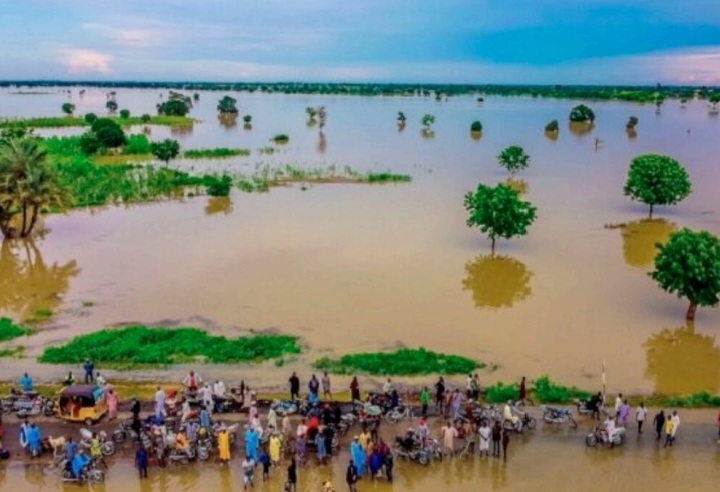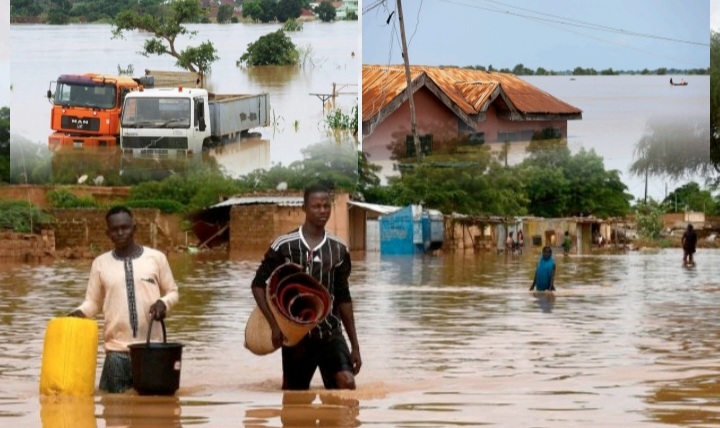Danger: NiMet raises alarm on imminent flood disaster in Nigeria

The Nigerian Meteorological Agency (NiMet) in its latest weather outlook for the upcoming days, has urged disaster risk managers, government agencies, and individuals to take proactive measures to safeguard lives and property against potential flood hazards.
The forecast, covering the period from August 15th to August 17th, 2023, offers valuable insights into the expected weather patterns across various regions of Nigeria.
With the prediction of moderate to heavy rainfall and the possibility of flash floods, it is imperative that a collective effort is made to avert potential losses.
The agency’s Lagos Territorial Coordinator, Ibrahim Farinloye, conveyed this vital information in an official statement released on Monday in Lagos.
The states mentioned are Delta, Ekiti, Ondo, Lagos, Anambra, Ogun, Nasarawa, Cross River, Bauchi, Jigawa, Osun, Kwara, Zamfara, Sokoto, Adamawa, Taraba, Benue, and Imo.
Within these states, a total of 56 communities are believed to be susceptible to the effects of the anticipated heavy rainfall and subsequent flooding, according to the statement.
Among the communities most vulnerable are Delta State’s Aboh, Ekiti State’s Ado Ekiti, and Ondo State’s Akure, Idanre, Ifon, Iju Itaogbolu, Ogbese, Owo, Owena, and Ondo are highlighted.
In Lagos State, the alert extends to Apapa, Badagry, Eti Osa, Ikeja, Ikorodu, Ikoyi, Lagos Island, Ojo Lagos, and Surulere.
Anambra State’s Atani, Ogun State’s Ifo, Ota, and Sagamu, as well as Nasarawa State’s Lafia and Wamba, also feature on the list of potentially affected regions.
Cross River State’s Ikom and Ogoja, Bauchi State’s Jamaare, Misau, Azare, Itas, Kafin Madaki, Kari, Kirfi, Tafawa Balewa, and Katagum, along with Jigawa State’s Hadejia and Miga, and Osun State’s Ilesa and Oshogbo, are additional locations susceptible to the impending heavy rainfall.
Kwara State’s Kosubosu, Zamfara State’s Anka, Bungudu, and Gusau, Sokoto State’s Goronyo, Adamawa State’s Numan and Shelleng, Taraba State’s Serti, Benue State’s Ito, Katsina-Alan, and Vande-Ikya, as well as Imo State’s Oguta and Orlu are identified as communities that could potentially be impacted by the weather conditions.
The call to action is directed at a range of stakeholders, including disaster risk managers, government agencies responsible for emergency response, and every individual residing in areas at risk of experiencing heavy rainfall and flooding. Proactivity is the key to minimizing the impact of adverse weather conditions.
For disaster risk managers and relevant agencies, this weather forecast serves as a vital tool for preparedness and strategic coordination.

The potential consequences of the forecasted rainfall—such as flash floods—highlight the need for these entities to swiftly activate their response mechanisms.
This involves pre-positioning resources, enhancing communication networks, and maintaining a state of readiness to provide timely assistance to affected communities.
Incorporating lessons learned from previous rainy seasons, disaster risk managers must ensure that evacuation plans are up-to-date and that shelters are well-equipped and strategically located.
Furthermore, close collaboration with meteorological agencies is essential for receiving real-time updates and making informed decisions based on evolving weather conditions.
While disaster risk managers and agencies play a critical role, individuals within communities must also take responsibility for their safety and that of their families.
This entails staying informed about weather forecasts and heeding any warnings or alerts issued by relevant authorities. A proactive approach involves:
• Early Preparations: Identifying vulnerable areas within neighborhoods and taking preemptive measures such as elevating valuables, reinforcing homes, and securing loose objects that could become hazards in strong winds.
• Emergency Kits: Assembling emergency kits containing essentials such as non-perishable food, clean water, medications, important documents, and a flashlight. These kits can prove invaluable in the event of displacement or power outages.
• Evacuation Plans: Designating safe meeting points and routes for evacuation. Communicating these plans with family members ensures that everyone knows what to do in the event of an emergency.
• Staying Informed: Regularly monitoring weather updates from reliable sources, such as NiMet, and adhering to advisories issued by local authorities.
• Community Engagement: Communities can organize drills, workshops, and information sessions to raise awareness about flood risk and preparedness. Sharing knowledge empowers everyone to contribute to collective safety.
In light of the imminent rainy season, disaster risk managers, government agencies, and individuals must come together to form a formidable front against potential risks.
By being proactive, informed, and prepared, lives can be saved, and the impact of natural disasters can be significantly mitigated. With a united effort, Nigeria can navigate the challenges of the rainy season with resilience and determination.
